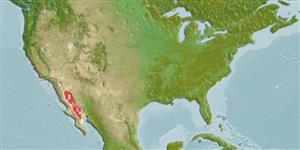Actinopterygii (ray-finned fishes) >
Clupeiformes (Herrings) >
Engraulidae (Anchovies) > Engraulinae
Etymology: Anchoa: Italian ancioa = anchovy (Ref. 45335).
Environment / Climate / Range
Ecology
Marine; pelagic-neritic; depth range 0 - 50 m (Ref. 189). Subtropical, preferred ?; 32°N - 25°N, 116°W - 110°W (Ref. 189)
Eastern Central Pacific: northern part of the Gulf of California to Sonora, Mexico.
Size / Weight / Age
Maturity: Lm ? range ? - ? cm
Max length : 8.5 cm SL male/unsexed; (Ref. 189)
Dorsal
spines
(total): 0;
Anal
spines: 0;
Anal
soft rays: 17 - 21. Body rather elongate, but somewhat compressed. Snout fairly long, almost equal to eye diameter; maxilla moderate, tip bluntly pointed, reaching onto inter-operculum, but not to edge of gill cover; panamensis-type gill cover canals. Anal fin origin a little behind midpoint of dorsal fin base. Silver stripe along flank, deeper above anal fin (more than eye diameter).
Occurs in coastal waters. More data needed.
Life cycle and mating behavior
Maturity | Reproduction | Spawning | Eggs | Fecundity | Larvae
Spawn in school (Ref. 205).
Whitehead, P.J.P., G.J. Nelson and T. Wongratana, 1988. FAO Species Catalogue. Vol. 7. Clupeoid fishes of the world (Suborder Clupeoidei). An annotated and illustrated catalogue of the herrings, sardines, pilchards, sprats, shads, anchovies and wolf-herrings. FAO Fish. Synop. 125(7/2):305-579. Rome: FAO. (Ref. 189)
IUCN Red List Status (Ref. 115185)
CITES (Ref. 94142)
Not Evaluated
Threat to humans
Harmless
Human uses
More information
ReferencesAquacultureAquaculture profileStrainsGeneticsAllele frequenciesHeritabilityDiseasesProcessingMass conversion
Tools
Special reports
Download XML
Internet sources
Estimates of some properties based on models
Phylogenetic diversity index (Ref.
82805): PD
50 = 0.5000 [Uniqueness, from 0.5 = low to 2.0 = high].
Bayesian length-weight: a=0.00501 (0.00221 - 0.01134), b=3.15 (2.97 - 3.33), in cm Total Length, based on LWR estimates for this Genus-body shape (Ref.
93245).
Trophic Level (Ref.
69278): 3.4 ±0.4 se; Based on size and trophs of closest relatives
Resilience (Ref.
69278): High, minimum population doubling time less than 15 months (Preliminary K or Fecundity.).
Vulnerability (Ref.
59153): Low vulnerability (12 of 100) .
